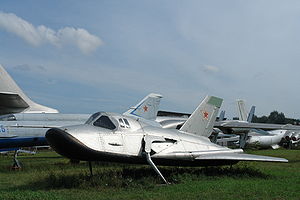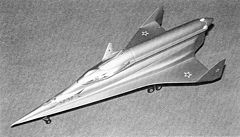Mikoyan-Gurevich MiG-105 Video - Historical video
|
|
Mikoyan-Gurevich MiG-105
MiG-105

Picture - MiG 105-11 test vehicle at the Monino Air Force museum.
Role: Test vehicle
Manufacturer: Mikoyan-Gurevich
First flight: 1976
Status: Cancelled
Primary user: Soviet Air Force
The Mikoyan-Gurevich MiG-105 was a manned test vehicle to explore low-speed handling and landing. It was a visible result of a Soviet project to create an orbital spaceplane. This was originally conceived in response to the American X-20 Dyna-Soar military space project and may have been influenced by contemporary manned lifting body research being conducted by NASA's Flight Research Center in California. The MiG 105 was nicknamed "Lapot" Russian: –Ľ–į–Ņ–ĺ—ā—Ć, or bast shoe (the word is also used as a slang for "shoe") for the shape of its nose.
Development

Picture - Spiral 50 / 50. The spaceplane and its liquid fuel booster stage mated to its hypersonic mothership carrier
The program was also known as EPOS (Russian acronym for Experimental Passenger Orbital Aircraft). Work on this project finally began in 1965, two years after Dyna-Soar's cancellation. The project was halted in 1969, to be briefly resurrected in 1974 in response to the US Space Shuttle Program. The test vehicle made its first subsonic free-flight test in 1976, taking off under its own power from an old airstrip near Moscow. It was flown by pilot A. G. Festovets to the Zhukovskii flight test center, a distance of 19 miles. Flight tests, totaling eight in all, continued sporadically until 1978. The actual space plane project wac cancelled when the decision was made to instead proceed with the Buran project. The MiG test vehicle itself still exists and is currently on display at the Monino Air Force Museum in Russia.
Gleb Lozino-Lozinskiy was the leader of the Spiral development programme.
Differences between Dyna-Soar and Spiral
Although having basically the same mission, Dyna-Soar and Spiral were radically different vehicles. For example:
While the X-20 Dyna-Soar was designed for launch atop a conventional expendable rocket such as the Titan III-C or Saturn I, Soviet engineers opted for a midair launch scheme for Spiral. Known as "50 / 50", the idea was that the spaceplane and a liquid fuel booster stage would be launched at high altitude from the back of a large, airbreathing mothership travelling at hypersonic speeds. The idea was similar to that used by the United States in launching the D-21 Tagboard reconnaissance drone from the back of the A-12 Oxcart. The mothership was to have been built by the Tupolev Design Bureau (OKB-156) and utilize many of the same technologies developed for the Tu-144 'Charger' supersonic transport (The Soviet equivalent of the Concorde) and the Sukhoi T-4 mach-3 bomber (somewhat similar to the XB-70 Valkyrie). It never made it off the drawing boards. The U.S. purportedly flew a similar design in the 1990s under the secret Blackstar project.
Dyna-Soar was designed with a fixed, delta-wing planform, while Spiral featured an innovative variable-geometry wing. During launch and reentry, these were folded against the sides of the vehicle at a 60-degree angle, acting as vertical stabilizers. After dropping to subsonic speeds post-reentry, the pilot activated a set of electric actuators which lowered the wings into the horizontal position, giving the spaceplane better flight characteristics.
Spiral was built to allow for a powered landing and go-around maneuver in case of a missed landing approach. An air intake for a single Koliesov turbojet was mounted beneath the central vertical stabilizer. This was protected during launch and reentry by an electric clamshell door, which would open at subsonic speeds. By comparison, Dyna-Soar was designed primarily for a once-off, unpowered deadstick landing, although some documentation claims that its emergency solid-fuel escape rocket (the third stage engine from an LGM-30 Minuteman ICBM) could be used for a go-around maneuver if necessary.
Spiral was designed as a lifting body, while Dyna-Soar was designed more like a conventional aircraft.
High temperature superalloy metals such as niobium, molybdenum, tungsten and rene 41 were to have been used in the heatshield structure of the X-20. Spiral was to have been protected by what Soviet engineers termed "scale-plate armour": individual steel plates hung from articulated ceramic bearings to allow for thermal expansion during reentry. Several BOR (Russian acronym for Unpiloted Orbital Rocketplane) craft were built and launched to test this concept.
In the event of a booster explosion or in-flight emergency, the insulated crew compartment of Spiral was designed to separate from the rest of the vehicle and parachute to earth like a conventional ballistic capsule; this could occur at any point in the flight. Such an escape crew capsule was also considered for Dyna-Soar, but American engineers eventually opted for a solid-fuel escape rocket that would kick the spaceplane away from an exploding booster, saving both pilot and spacecraft.
Much like today's Space Shuttle, Dyna-Soar was designed with a small payload bay behind the pressurized crew module. This could be used for lofting small satellites, carrying surveillance equipment, weapons or even an extra crewmember in a pop-in cockpit. Spiral, on the other hand, appears to have been intended to carry only its pilot. Presumably, this was because the extra space which could have held a payload bay was needed for the Koliesov turbojet and its fuel tanks.
Both Dyna-Soar and Spiral were designed to land on skids. The landing skids on Dyna-Soar were designed to deploy from insulated doors on the underside of the vehicle, like a conventional aircraft. Soviet engineers, most likely concerned about heatshield integrity, designed the landing skids on Spiral to deploy from a set of doors on the sides of the fuselage just above and ahead of the wings. This unusual arrangement resulted in a hard landing on at least one occasion.
Pilots
A cosmonaut training group for pilots assigned to fly this vehicle was formed in the early 1960s. It went through many changes and was eventually dissolved entirely. Known members included:
Gherman Titov, the Soviet Union's second man in space (see Vostok 2 mission).
A.G. Fastovets, who piloted the vehicle during the majority of its atmospheric tests.
Uragan
Although Spiral itself never made it to the launch pad, it is rumoured that the design was reused and enlarged to build a piloted space interceptor known as "Uragan" (Russian for "Hurricane") in the 1980s. This craft was to have been launched by a Ukrainian-built Zenit expendable booster and was intended to intercept and destroy (if necessary) military Space Shuttle missions launched from Vandenberg Air Force Base. Its armament purportedly consisted of space-to-space missiles.
It is not known how many times the vehicle flew into space, if any. It is known that two Soviet Air Force cosmonaut groups, consisting of six in the first group and at least three in the second, were selected and trained to pilot the vehicle. The possibility that the shuttles could now be intercepted and shot down caused quite a stir in the US Department of Defense at the time, which issued several artists' conceptions showing the vehicle on the pad, in space, etc.
After the fatal Space Shuttle Challenger disaster prompted NASA and the DoD to cancel all planned launches from Vandenberg, it is said that the Soviet Union had no further need for the craft and, in turn, cancelled the Uragan program.
To this day, Russian officials continue to deny that this craft ever existed, leading some to believe that the purported space interceptor was all part of a successful Soviet disinformation program meant to scare the American military into thinking twice about its plans for the Space Shuttle.
The current whereabouts of any completed Uragan craft or components, if they exist, are unknown.
BOR
The –Ď–ě–† (Russian: –Ď–Ķ—Ā–Ņ–ł–Ľ–ĺ—ā–Ĺ—č–Ļ –ě—Ä–Ī–ł—ā–į–Ľ—Ć–Ĺ—č–Ļ –†–į–ļ–Ķ—ā–ĺ–Ņ–Ľ–į–Ĺ, Bespilotnyi Orbital'nyi Raketoplan, "Unpiloted Orbital Rocketplane"). Another spacecraft to use the Spiral design was the BOR series, unmanned subscale reentry test vehicles. American analogs X-23 PRIME and ASSET. Several of these craft have been preserved in aerospace museums around the world.
Operators
Soviet Union
Soviet Air Force
Specifications (MiG 105-11)
Data from Soviet X-planes; Yefim Gordon, Bill Gunston
General characteristics
Crew: 1
Length: 10.6m (including instrument boom) (ft in)
Wingspan: 6.7m (ft in)
Height: m (ft in)
Wing area: 24m≤ (258ft≤)
Empty weight: 3500kg (lb)
Loaded weight: 4220kg (lb)
Useful load: kg (lb)
Max takeoff weight: kg (lb)
500Kg Fuel
Performance
Never exceed speed: km/h (knots, mph)
Maximum speed: 800km/h (knots, mph)
Cruise speed: km/h (knots, mph)
Stall speed: km/h (knots, mph)
Range: km (nm, mi)
Service ceiling: m (ft)
Rate of climb: m/s (ft/min)
Wing loading: kg/m≤ (lb/ft≤)Landing speed 250-270 km/h
Buran
Space Shuttle
Comparable aircraft
X-20 Dyna-Soar
X-24
X-38 CRV
Living Warbirds: The best warbirds DVD series.
Source: WikiPedia